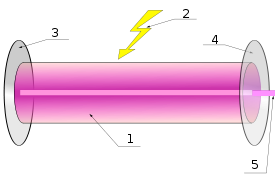- Output coupler
-
An output coupler (OC) is a partially reflective mirror used in lasers to extract a portion of the laser beam from the optical resonator.
Lasers operate by reflecting light between two or more mirrors which have an active laser medium between them. The medium amplifies the light by stimulated emission. For lasing to occur, the gain of the active medium must be larger than the total loss, which includes both unwanted effects such as absorption, and the intentional release of energy through the output coupler. In other words the laser must attain threshold.
There are two important properties of the output coupler:
- Radii of curvature
- The output coupler may be either flat or curved, depending on the design of the optical cavity. The face of the output coupler facing into the cavity is the side with the applied partially-reflective coating. This is the side which partially determines the laser modal properties. If this inner surface is curved then so must be the outer surface. This will stop the OC performing as a lens. The curvature of the outer surface can be designed to give a collimated laser output. This outer surface generally has an anti-reflection coating applied to maximise the output power.
- Reflectivity
- Depending on the gain of the medium, the amount of light the OC needs to reflect back can vary widely. Helium-neon lasers require around a 99% reflective mirror to lase, while nitrogen lasers have an extremely high gain (they are "superradiant") and do not require any OC (0% reflective). The reflectivity of any OC will vary with wavelength. A particular mirror may have a tuning range as low as a 10nm or so. For this reason the spectral properties of the OC are important to consider when a laser cavity is being assembled.
See also
Categories:- Laser science
- Mirrors
Wikimedia Foundation. 2010.

